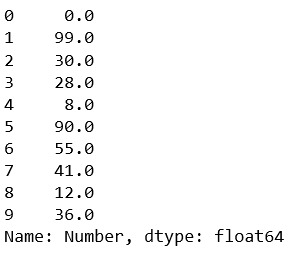Python是進行數據分析的一種出色語言,主要是因為以數據為中心的python軟件包具有奇妙的生態係統。 Pandas是其中的一種,使導入和分析數據更加容易。
pandas.to_numeric()是Pandas中的常規函數之一,用於將參數轉換為數字類型。
用法: pandas.to_numeric(arg, errors=’raise’, downcast=None)
參數:
arg:列表,元組,一維數組或係列
errors:{'ignore','raise','coerce'},默認為'raise'
->如果為“ raise”,則無效的解析將引發異常
->如果為“強製”,則無效的解析將設置為NaN
->如果為“ ignore”,則無效的解析將返回輸入
downcast:[默認無]如果不為None,並且數據已成功轉換為數字dtype,則根據以下規則將結果數據轉換為可能的最小數字dtype:
->“整數”或“有符號”:最小的有符號整數dtype(最小值:np.int8)
->‘unsigned’:最小的unsigned int dtype(最小值:np.uint8)
->“ float”:最小float dtype(最小值:np.float32)
返回:如果解析成功,則為數字。請注意,返回類型取決於輸入。如果為Series,則為Series,否則為ndarray。
代碼1:
首先觀察該數據集。我們將使用此數據的“數字”列來進行序列化,然後進行操作。
# importing pandas module
import pandas as pd
# making data frame
df = pd.read_csv("https://media.geeksforgeeks.org/wp-content/uploads/nba.csv")
df.head(10)
在Number列上調用Series構造函數,然後選擇前10行。
# importing pandas module
import pandas as pd
# making data frame
df = pd.read_csv("nba.csv")
# get first ten 'numbers'
ser = pd.Series(df['Number']).head(10)
ser輸出:

使用pd.to_numeric()方法。請注意,通過使用downcast =“ signed”,所有值都將轉換為整數。
pd.to_numeric(ser, downcast ='signed')輸出:

代碼2:使用錯誤=“忽略”。它將忽略所有非數字值。
# importing pandas module
import pandas as pd
# get first ten 'numbers'
ser = pd.Series(['Geeks', 11, 22.7, 33])
pd.to_numeric(ser, errors ='ignore')輸出:

代碼3:使用錯誤=“強製”。它將用NaN替換所有非數字值。
# importing pandas module
import pandas as pd
# get first ten 'numbers'
ser = pd.Series(['Geeks', 11, 22.7, 33])
pd.to_numeric(ser, errors ='coerce')輸出:

相關用法
- Python next()用法及代碼示例
- Python os.dup()用法及代碼示例
- Python set()用法及代碼示例
- Python Decimal max()用法及代碼示例
- Python PIL ImageOps.fit()用法及代碼示例
- Python os.rmdir()用法及代碼示例
- Python sympy.det()用法及代碼示例
- Python Decimal min()用法及代碼示例
- Python os.readlink()用法及代碼示例
- Python os.writev()用法及代碼示例
- Python os.readv()用法及代碼示例
- Python PIL RankFilter()用法及代碼示例
- Python os.rename()用法及代碼示例
- Python os.sendfile()用法及代碼示例
注:本文由純淨天空篩選整理自Shivam_k大神的英文原創作品 Python | pandas.to_numeric method。非經特殊聲明,原始代碼版權歸原作者所有,本譯文未經允許或授權,請勿轉載或複製。
